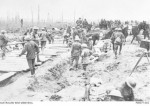DAVIES, Percival Naunton
Percival Naunton Davies was the son of John Davies and his wife, Mary Elizabeth Auguste Fischer. John Davies owned an iron foundry, Davies and Baird, and his son followed in his father's trade. Born in 1883, he married Irene Myra Scott in 1916, and they were to have three children: Margaret b.1920 d.1980, Kathleen b.1922 d. 1990 and John Scott b.1929 d.1991.
At the time he enlisted on 2 September 1916, Myra and Percival Davies were living at 121 Powlett St., East Melbourne, but he also gave a 'permanent address' as 'Rookby' Heidelberg Rd., Ivanhoe, probably his parents' house. After training at Seymour as a sapper with the Engineering Reinforcements, his trade skills saw him allocated to the 3-9 Reinforcements of the 2nd Pioneer Battalion, the groups of trade specialists who were the engineering corps for the various battalions, digging the trenches, laying the duckboards for the soldiers to walk on, setting up systems of messaging, building shelters and tunnels. Colonel E.J. Nicholson, writing in 1919, described them thus:
The result of the Engineers' work, assisted by skilled men from the infantry, was so satusfactory that it was decided in Egypt, on the return from Gallipoli, to form a pioneer battalion for each division ... Altogether about 62 different trades were represented. The physique of the men was of a very high standard and, with four exceptions, were all chosen from other ranks - mainly a fine stamp of engineer NCO's ... the engineer was the architect, the pioneer the contractor. His work was very hard; his losses were great for he never slackened ... the very pick of the finest kind of tradesman or worker, miner, carpenter, mason, quarryman, plate-layer, road worker.
The 2nd Pioneer Battalion recruits embarked from Melbourne on 23 November, 1916, headed for Plymouth. They travelled on HMAS Hororata A20, landing on 29 January, 1917, and were taken on strength on 30 January. After further training, they were sent to France and the Western Front on 19 April. On 7 May, they marched out to be taken on strength with the Battalion. In March, 1916, the 2nd Division had been placed in the 'nursery' sector at Armentieres, but in July 1917, they moved to the front to fight at Pozieres and it was here that Percival Davies would have been exposed to the full brunt of the German assault. The 2nd Pioneers were at the Somme for the remainder of the year and would have been with the 2nd Divison in March 1918 when they helped push the German troops back to the Hindenburg line.
On 1 December, 1917, Percival Davies was taken ill and sent to hospital, only to return and on 10 December, sprain an ankle. On 15 December, he again joined his battalion at the front and remained with them until 19 May 1918, when he was seriously wounded with a gunshot wound to the left thigh. He was returned to England on the hospital ship Brighton and admitted to the War Hospital at Warren Rd., Guildford, where his left leg was amputated on 25 May. Two months later, he was transferred to the 2nd Auxiliary Hospital at Southall, Middlesex, which specialised in the fitting of artificial limbs. Rather than a swift recovery, however, by 15 October the stump was septic. It must have been a dreadful period of pain and a tedious recovery. It is not clear how long his recuperation took, but on 6 January, 1919, he was returned to Australia on board H.S. Kanowna.
For a brief period in 1919, he and Myra continued to live at 121 Powlett St., but then moved to 71 Cassell's St., Brunswick North and then to 630 Heidelberg Rd. where on 3 April, 1920, he was finally discharged from the AIF as medically unfit. In 1924, they moved to Toora St., Ivanhoe and he wrote his occupation as ironfounder. They were still there in 1931.
Perceval Naunton Davies died at Kew in 1960, aged 77.
Australian National Archives Service Record
Australian War Memorial, Embarkation Record
Acrestry.com.au, Public Member Tress, Birth, Marriage and Death Indexes

